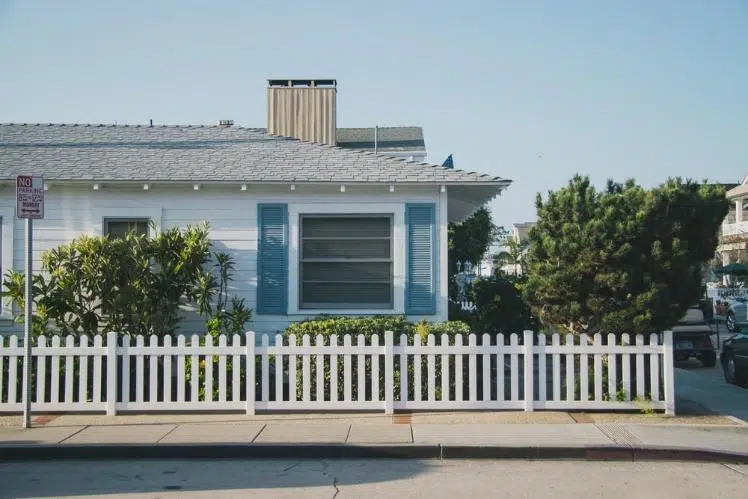P (972) 898-1307 | F (972) 499-1188
Types and Styles of Wood Fences

Wood is a traditional fencing material that continues to be one of the most popular choices. An elegant and stylish wood fence can increase privacy, boost security, and increase property value, making it a great investment for any homeowner. In this article, we explore some of the best types and styles of wood fences.
Types and Styles of Wood Fences
Here is a list of the most cost-effective and common fence styles. Note that the cost of hardware such as hinges and the type of gate latches you use is going to be the same regardless of which fence ideas you pick.
1. Lattice Fence
Wooden lattice fences are a popular kind of fencing that adds beauty and privacy to any home. A lattice features thin diagonal slats shaped in a crisscross pattern. The crisscross pattern creates square-shaped holes that give an incredible look to the fence.
You can get lattice fences in three more common styles – horizontal, arch, and crosshatch styles. Cedarwood and redwood are typically used to construct lattice fences. The best thing about lattice fences is that you can paint them in any color you prefer. Nevertheless, modern homeowners usually prefer red or white fences.
2. Wood Dog-Ear Fence
Of all the types, the wood dog-ear fence is the cheapest and simplest. You make these kinds of wood fences on your own by placing the wood panels alongside any space between them. In order to end the monotony of the design, the top edges of the fence pickets are cut at an angle to resemble the shape of a dog’s ear. The angles add character and dimension.
A wood dog-ear fence provides your family with complete privacy. It also ensures that your pets and toddlers stay inside.
3. Post and Rail Fence
Post and rail fences are an iconic option, often seen in classic movies surrounding farms and ranches. These fences prevent livestock from being able to roam around and are usually considered functional instead of ornamental.
In a post and rail fence, the horizontal posts are generally 5 feet tall and 6 feet apart. They can have two, three, or four horizontal rails and might include struts to prevent the rails from sagging. They also prevent large livestock from wandering outside. However, they do little to stop cats and dogs from entering and don’t offer any privacy.
4. Picket Fence
A picket fence symbolizes Americana, denoting an iconic status of the ideal middle-class life. When you think of a white picket fence, you instantly imagine a nice house in the suburbs with the family pet and kids running around in the yard. It even denotes the peaceful and calm lifestyle of a quiet, middle-class neighborhood.
These days, picket fences are an ornamental way to keep children and pets inside their homes. Homeowners generally use whitewashed or wooden picket fences in their back or front yards. Several contemporary homes also feature picket fences made with PVC.
5. Wood Louver Fence
Louver fences are similar to rail fences, where there are horizontal slats with vertical posts. However, in these fences, the side-to-side boards have a smaller width and are mounted quite densely.
There are spaces between the boards that are small enough to offer privacy but let air flow through the fence. You can overlap these boards and install them at a diagonal to lower the gaps between them while still letting air flow.
Wooden louver fences are perfect for patios, pool decks, or small backyards where you only need visual privacy.
6. Wood Vertical Board Fence
Like wood louver fences, vertical fences have boards packed densely in the vertical direction along the rails. You can either install them closely together on a single side of the rails, or you can alternate on either side of the rail.
Going with the second option allows proper airflow and small animals to pass through along with the air. However, at a specific viewing angle, you don’t get any visual privacy. Nevertheless, it’s not as bad as it sounds. An individual would have to stand still at a distance to see what’s happening inside your property.
7. Solid Wood Panel Fence
The solid panel fence doesn’t have any air gaps. The wood is mounted side-by-side on both sides of the rails. They will generally have caps on their post along with other decorative features. However, the main thing to note is that they are sturdy, tall, and extremely robust.
The issue with these wood fence options is that no animals, no air, no visual sight lines, and no leaves can pass through. This means that strong gusts of wind can possibly damage or knock over these solid wood panels.
8. Woven Panels
Basketweave and other woven fence panels are quite decorative. Plus, they can even do a great job of increasing security and privacy, minimizing wind and noise, and creating a barrier. Nevertheless, they require regular maintenance and painting them can be challenging as you have to try and get into the weave. Moreover, woven panels tend to be costlier than other types of fences due to the amount of work that goes into manufacturing them.
9. Shadowbox
A shadowbox fence is constructed by alternating fence boards on either side of the fence. The lower part of the fence looks quite similar to dog-ear fencing. The fence appears the same on both sides.
When you look directly at the fence, you will see overlapping boards on opposite sides. With that said, at any angle, the fence isn’t private and allows one to see through.
Last Few Words
At Texas State Fence, we can help you choose and install the best wood fence for your home. We cater to customers across Texas with affordable and innovative solutions designed to stand the test of time. If you want to build a wood fence or are looking for other types of fencing, call us at (972) 898-1307 or visit our website.

